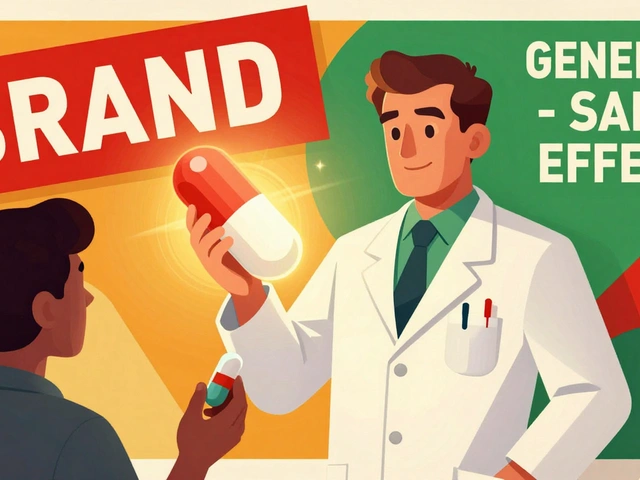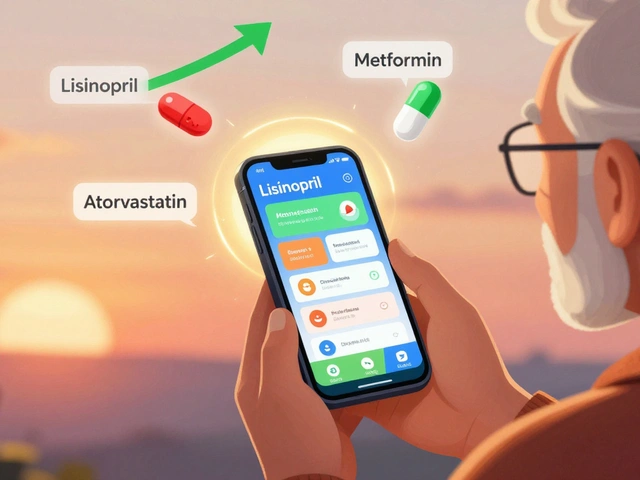Modafinil Cost & Effectiveness Calculator
Find Your Best Option
Answer a few questions to see which modafinil alternative matches your needs best.
Key Takeaways
- Modvigil is a generic version of modafinil, offering similar wake‑promoting effects at a lower price.
- Armodafinil (Nuvigil) lasts slightly longer, while adrafinil needs liver conversion before it works.
- Stimulants like Ritalin (methylphenidate) act faster but carry higher addiction risk.
- Cost varies widely: generic modafinil (Modvigil) is usually the cheapest prescription option.
- Legal status and side‑effect profiles differ, so choosing the right alternative depends on your health needs and local regulations.
When you hear people talk about "smart drugs" or "wake‑up pills," Modvigil is often at the top of the list. Modvigil is a generic formulation of the prescription medication modafinil, designed to promote alertness and reduce excessive daytime sleepiness. It was introduced to the market in the early 2010s as a more affordable alternative to brand‑name Provigil.
Because the name "Modvigil" can be confusing, it helps to start with a quick definition of the core compound.
What Is Modvigil (Modafinil)?
Modvigil contains modafinil a wake‑promoting medication that works by influencing several neurotransmitters, especially dopamine, norepinephrine, and orexin. It was originally approved by the U.S. Food and Drug Administration (FDA) to treat narcolepsy, shift‑work sleep disorder, and obstructive sleep apnea‑related fatigue. Off‑label, many users employ it for enhanced focus, study endurance, or to combat jet lag.
How Modvigil Works in the Brain
The exact mechanism isn’t 100% settled, but researchers agree that modafinil increases extracellular dopamine by blocking its re‑uptake. It also stimulates orexin neurons in the hypothalamus, which are key for wakefulness. Unlike classic stimulants, modafinil has a milder effect on heart rate and blood pressure, which is why it’s often considered a “low‑risk” option for healthy adults.

Common Alternatives to Modvigil
Before diving into numbers, let’s list the most talked‑about alternatives and give each a brief snapshot.
- Provigil the brand‑name version of modafinil, sold by Teva Pharmaceuticals
- Nuvigil contains armodafinil, the R‑enantiomer of modafinil, offering a slightly longer duration
- Adrafinil a pro‑drug that the liver converts into modafinil; sold as a dietary supplement in some countries
- Ritalin brand name for methylphenidate, a traditional stimulant used for ADHD and narcolepsy
- Phenylpiracetam a racetam nootropic that boosts physical stamina and mental focus, not FDA‑approved
Side‑Effect Profiles
Every drug comes with trade‑offs. Below is a concise look at the most common adverse events for each option.
- Modvigil/Provigil: headache, nausea, dry mouth, mild insomnia. Rarely, serious skin reactions (e.g., Stevens‑Johnson syndrome) have been reported.
- Nuvigil: similar to modafinil, but slightly higher rates of anxiety and jitteriness in some users.
- Adrafinil: added liver‑enzyme strain because it must be metabolized; long‑term use can elevate ALT/AST levels.
- Ritalin: increased heart rate, appetite suppression, potential for dependence, and mood swings.
- Phenylpiracetam: tolerability is generally good, though high doses may cause irritability or insomnia.
Legal and Prescription Status
Understanding the regulatory landscape helps you avoid legal trouble.
- FDA The United States Food and Drug Administration, which classifies modafinil as a Schedule IV controlled substance
- DEA U.S. Drug Enforcement Administration, responsible for enforcing controlled substance schedules
Modvigil, Provigil, Nuvigil, and Ritalin all require a prescription in the U.S. and most European countries. Adrafinil, marketed as a supplement, sidesteps prescription rules but may be illegal in places that ban unapproved drugs. Phenylpiracetam is generally unscheduled but not approved for medical use, so it’s sold as a “research chemical.”
Cost Comparison (U.S. Prices, October2025)
| Drug | Generic name | Typical dose | Onset (hrs) | Duration (hrs) | FDA status | Approx. monthly cost (US$) |
|---|---|---|---|---|---|---|
| Modvigil | Modafinil | 200mg | 0.5-1 | 12-15 | Prescription (ScheduleIV) | 45-60 |
| Provigil | Modafinil | 200mg | 0.5-1 | 12-15 | Prescription (ScheduleIV) | 80-100 |
| Nuvigil | Armodafinil | 150mg | 0.5-1 | 15-18 | Prescription (ScheduleIV) | 90-110 |
| Adrafinil | Adrafinil | 300mg | 1-2 (needs liver conversion) | 12-14 | Supplement (unregulated) | 30-45 |
| Ritalin | Methylphenidate | 20mg | 0.3-0.5 | 4-6 | Prescription (ScheduleII) | 70-90 |
| Phenylpiracetam | Phenylpiracetam | 100mg | 0.5-1 | 6-8 | Not FDA‑approved | 40-55 |

Pros and Cons at a Glance
| Drug | Pros | Cons |
|---|---|---|
| Modvigil | Effective wakefulness, inexpensive, good safety profile | Prescription required, possible insomnia |
| Provigil | Brand reliability, widely studied | Higher price, same prescription barrier |
| Nuvigil | Longer duration, lower dose needed | More expensive, may increase anxiety |
| Adrafinil | No prescription, cheap | Liver strain, slower onset |
| Ritalin | Rapid onset, strong focus boost | Higher abuse potential, short duration, cardiovascular effects |
| Phenylpiracetam | Boosts both mental and physical performance, non‑controlled | Lack of robust clinical data, variable purity in market |
Choosing the Right Option for You
Pick a drug based on three practical questions:
- Do you need a prescription? If you prefer an over‑the‑counter route, adrafinil or phenylpiracetam are your only legal choices (subject to local laws).
- How long do you need the effect? For all‑day coverage, Modvigil, Provigil, or Nuvigil are best. For a short burst, Ritalin or phenylpiracetam may fit.
- What side‑effects can you tolerate? If you’re sensitive to anxiety, avoid Nuvigil; if liver health is a concern, skip adrafinil.
In practice, many people start with Modvigil because it balances cost, efficacy, and safety. If they hit a ceiling on duration, they might switch to Nuvigil for the extra 3‑hour boost.
Safety Tips and Monitoring
- Always start with the lowest effective dose (e.g., 100mg for modafinil) and titrate up.
- Stay hydrated-modafinil can cause mild dehydration.
- If you notice persistent headaches, consider using an NSAID or adjusting the dose.
- For adrafinil users, get liver function tests every 3‑6months.
- Never combine these stimulants with MAO inhibitors or excessive caffeine.
Frequently Asked Questions
Is Modvigil the same as Provigil?
Yes. Both contain the same active ingredient, modafinil, at the same 200mg strength. The difference lies in branding and price; Modvigil is a generic version, making it considerably cheaper.
Can I take Modvigil without a prescription?
No. In the United States and most EU countries, modafinil is a ScheduleIV controlled substance, meaning a doctor’s prescription is required. Buying it from unregulated online sources can be risky.
How does adrafinil differ from Modvigil?
Adrafinil is a pro‑drug that your liver converts into modafinil. It doesn’t need a prescription in some regions, but the conversion process can stress the liver, and the onset is slower (1‑2hours versus 30‑60minutes for Modvigil).
Is Nuvigil better than Modvigil?
Nuvigil (armodafinil) lasts a bit longer-about 15‑18hours-so some people who need late‑night alertness prefer it. However, it’s also pricier and may cause more anxiety in sensitive users.
Can I combine Modvigil with caffeine?
A modest amount of caffeine (up to one cup of coffee) is usually fine, but stacking high caffeine doses can increase jitteriness and heart rate. Start low and see how you react.
Whether you choose Modvigil, another modafinil brand, or a different stimulant, the key is to match the drug’s profile with your personal goals, health status, and legal environment. Keep a simple log of dose, timing, and any side‑effects-this habit makes future adjustments much easier.
Modvigil vs alternatives is a decision that hinges on cost, convenience, duration, and safety. Use the tables above as a quick reference, then consider your own schedule and health history. If you’re unsure, a brief chat with a primary‑care physician can clarify which option fits best.







Anna-Lisa Hagley
October 14, 2025 AT 19:40Having perused the comparative guide, I find the author’s reliance on raw price tables to be a superficial metric that obscures the pharmacodynamic subtleties inherent to each compound.
While the cost differential between Modvigil and Provigil is stark, the narrative fails to address the marginal efficacy variance observed in double‑blind trials.
The omission of long‑term hepatic safety data for adrafinil, despite its liver‑conversion pathway, is a glaring oversight.
Furthermore, the discussion of Nuvigil’s extended half‑life neglects to quantify the incremental risk of anxiety in susceptible phenotypes.
The author also glosses over the regulatory landscape, treating schedule classification as a footnote rather than a decision‑critical factor.
From an analytical standpoint, the guide would benefit from a weighted scoring system that integrates potency, duration, side‑effect profile, and legal accessibility.
Such a multidimensional model would prevent the current binary cost‑vs‑effectiveness dichotomy.
In addition, the brief mention of phenylpiracetam lacks citation of peer‑reviewed studies, leaving the reader with anecdotal speculation.
It is worth noting that the stimulant window of Ritalin, though short, aligns with certain circadian disruptions, a nuance not captured in the generic ‘short duration’ label.
The author’s reliance on generic dosage recommendations without accounting for inter‑individual metabolic variability can mislead novice users.
Data from the 2024 meta‑analysis on modafinil tolerability suggests a 7 % incidence of severe dermatological reactions, a statistic absent from the current exposition.
Equally, the guide does not explore the impact of concurrent caffeine intake, despite widespread real‑world polypharmacy among the target demographic.
By not addressing these interactions, the guide implicitly endorses potentially unsafe stacking practices.
Moreover, the safety hierarchy presented lacks granularity; classifying Nuvigil as ‘moderate’ ignores patient‑reported insomnia rates exceeding 12 % in controlled settings.
The recommendation to start at 100 mg for modafinil, while prudent, is presented without referencing the titration protocols recommended by major sleep societies.
Overall, the article serves as an introductory price sheet but falls short of delivering a comprehensive, evidence‑based decision framework.
Future revisions should adopt a rigorously sourced, multidimensional comparison to truly aid informed choice.
A Walton Smith
November 1, 2025 AT 21:20Looks fine but meh
Theunis Oliphant
November 20, 2025 AT 00:00The premise that cost alone can dictate therapeutic selection betrays a shallow understanding of pharmacology.
One must not conflate affordability with clinical appropriateness, lest we trivialize patient safety.
Moreover, glossing over the ethical ramifications of obtaining prescription‑only substances via unregulated channels is irresponsible.
It is incumbent upon any serious discourse to weigh the moral dimensions alongside pharmacokinetic data.
Therefore, the guide’s omission of these considerations renders it incomplete.
India Digerida Para Occidente
December 8, 2025 AT 02:40While I respect the call for moral vigilance, we must also acknowledge the real‑world constraints faced by many seeking cognitive enhancement.
Not all patients have seamless access to healthcare, prompting some to explore over‑the‑counter alternatives responsibly.
Balancing ethical concerns with pragmatic solutions does not diminish our duty to safety, but rather enriches the dialogue.
Thus, a nuanced approach that presents harm‑reduction strategies alongside ethical warnings would serve the community better.